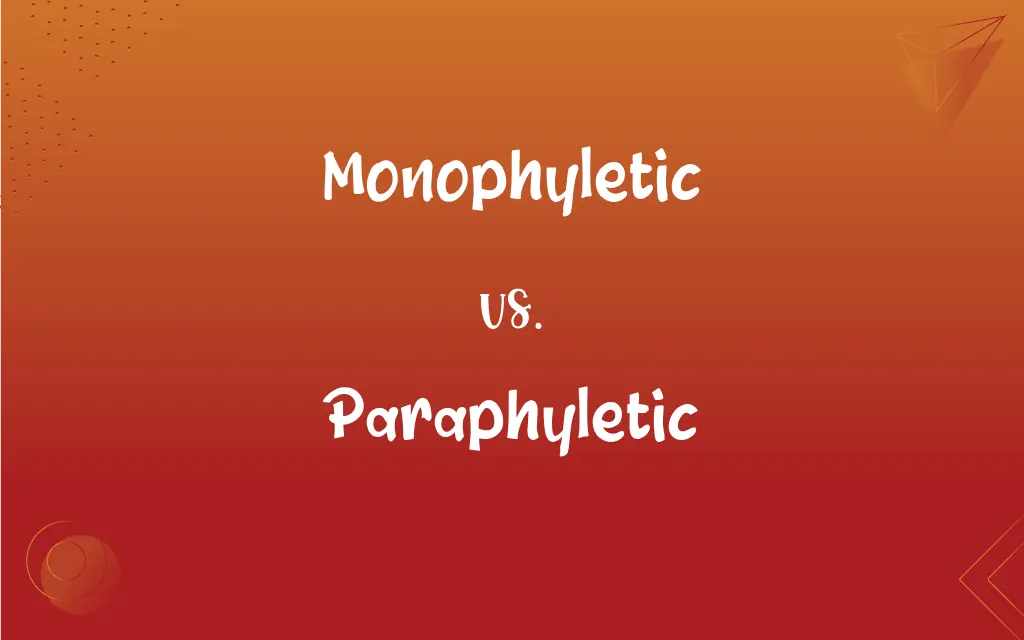Monophyletic vs. Paraphyletic: What's the Difference?
Edited by Aimie Carlson || By Janet White || Published on February 13, 2024
Monophyletic groups include an ancestor and all its descendants, while paraphyletic groups contain an ancestor and some, but not all, descendants.

Key Differences
A monophyletic group, in evolutionary biology, consists of a common ancestor and all of its descendants. This forms a complete branch on the tree of life. In contrast, a paraphyletic group includes a common ancestor and only some of its descendants, excluding at least one lineage.
Monophyletic groups are often referred to as "true clades" and represent a complete lineage in phylogenetic studies. Paraphyletic groups are incomplete clades, as they leave out one or more descendant groups that share the same common ancestor.
Understanding monophyletic groups is essential for clear and accurate phylogenetic trees, as they show the full evolution of a lineage. Paraphyletic groups, on the other hand, can be misleading in evolutionary studies as they do not represent the full diversity derived from a common ancestor.
Monophyletic groups are used in modern taxonomy to classify organisms based on common descent. Paraphyletic groups, while sometimes useful in certain ecological or morphological contexts, are generally viewed as less scientifically valid for evolutionary classification.
The distinction between monophyletic and paraphyletic groups is crucial in evolutionary biology for understanding the relationships and evolutionary history of different organisms. Monophyletic groups reflect a more accurate picture of evolutionary pathways than paraphyletic ones.
ADVERTISEMENT
Comparison Chart
Definition
Includes an ancestor and all its descendants
Includes an ancestor and some, but not all, descendants
Phylogenetic Accuracy
Represents a complete lineage
Incomplete, excludes some descendants
Usage in Taxonomy
Preferred for classifying organisms
Less valid for evolutionary classification
Representation in Phylogenetic Trees
A complete branch
A branch missing one or more lineages
Scientific Validity
Considered more scientifically valid
Less scientifically valid for showing evolution
ADVERTISEMENT
Monophyletic and Paraphyletic Definitions
Monophyletic
Essential for accurate evolutionary understanding.
Monophyletic groups clarify the evolutionary history of amphibians.
Paraphyletic
A group including a common ancestor and some, but not all, of its descendants.
Reptiles, excluding birds, form a paraphyletic group.
Monophyletic
Also known as a clade in phylogenetic studies.
The angiosperms form a monophyletic group in plant evolution.
Paraphyletic
Excludes at least one descendant lineage from a common ancestor.
Fishes, without tetrapods, are considered paraphyletic.
Monophyletic
Represents a complete lineage in a phylogenetic tree.
The mammalian clade is monophyletic, including all mammal species.
Paraphyletic
Less valid for evolutionary classification due to missing lineages.
Non-avian dinosaurs form a paraphyletic group as it excludes birds.
Monophyletic
A group consisting of a common ancestor and all its descendants.
Birds are a monophyletic group, descended from a common ancestor.
Paraphyletic
Represents an incomplete branch on the tree of life.
The paraphyletic grouping of gymnosperms excludes angiosperms.
Monophyletic
Used to classify organisms based on common descent.
The class Aves is monophyletic, encompassing all birds.
Paraphyletic
Sometimes used in ecological or morphological contexts.
Amphibians without direct descendants are a paraphyletic group.
Monophyletic
Of or relating to a group of taxa that includes the common ancestor of all the members as well as all descendants of that ancestor.
Paraphyletic
Of or relating to a group of taxa that includes the common ancestor of all the members but not all descendants of that ancestor.
Monophyletic
Of or derived from one stock or source.
Paraphyletic
(systematics) Of a defined group of taxa, not including all descendants of the most recent common ancestor of all members.
Monophyletic
(biology) Of, pertaining to, or affecting a single phylum (or other taxon) of organisms.
Monophyletic
(biology) Deriving from a single clade (monophylum).
Monophyletic
(biology) Descending from a single ancestral species.
Monophyletic
Descending from a single ancestral species and containing all descendants of that single ancestor, holophyletic.
Monophyletic
Descending from a single ancestral species but not containing all descendants of that ancestor, paraphyletic.
Monophyletic
(biology) congeneric
Monophyletic
Of or pertaining to a single family or stock, or to development from a single common parent form; - opposed to polyphyletic; as, monophyletic origin.
FAQs
What defines a monophyletic group?
It includes an ancestor and all its descendants.
Why are monophyletic groups important in taxonomy?
They accurately represent evolutionary relationships.
Do monophyletic groups show common descent?
Yes, they represent a lineage from a common ancestor.
Why might paraphyletic groups be used?
For ecological or morphological studies, despite their limitations.
Can a paraphyletic group become monophyletic?
Yes, if all descendant lineages are included.
Is a clade the same as a monophyletic group?
Yes, a clade is another term for a monophyletic group.
What's characteristic of a paraphyletic group?
It includes an ancestor and some, but not all, descendants.
Are reptiles a monophyletic group?
No, they're paraphyletic if birds are excluded.
Why are monophyletic groups preferred in evolutionary biology?
They provide a clearer and more complete evolutionary picture.
Can paraphyletic groups be misleading?
Yes, as they don't show complete evolutionary pathways.
Are amphibians monophyletic?
Yes, amphibians as a whole are monophyletic.
Are all birds part of a monophyletic group?
Yes, all birds share a common ancestor in a monophyletic group.
Do paraphyletic groups have a single common ancestor?
Yes, but they don't include all its descendants.
How does a monophyletic group appear on a phylogenetic tree?
As a complete branch from a single ancestor.
Are mammals a monophyletic group?
Yes, mammals form a monophyletic group.
How do monophyletic and paraphyletic groups differ in scientific validity?
Monophyletic groups are more scientifically valid for depicting evolution.
Can fishes be considered a paraphyletic group?
Yes, if excluding tetrapods, they are paraphyletic.
Is the concept of paraphyletic groups controversial?
Yes, due to their incomplete representation of evolutionary lineages.
Does a paraphyletic group include all descendants?
No, it excludes at least one descendant lineage.
Is the term "clade" used for paraphyletic groups?
No, it's specific to monophyletic groups.
About Author
Written by
Janet WhiteJanet White has been an esteemed writer and blogger for Difference Wiki. Holding a Master's degree in Science and Medical Journalism from the prestigious Boston University, she has consistently demonstrated her expertise and passion for her field. When she's not immersed in her work, Janet relishes her time exercising, delving into a good book, and cherishing moments with friends and family.
Edited by
Aimie CarlsonAimie Carlson, holding a master's degree in English literature, is a fervent English language enthusiast. She lends her writing talents to Difference Wiki, a prominent website that specializes in comparisons, offering readers insightful analyses that both captivate and inform.































































